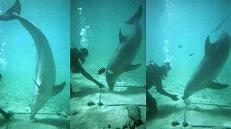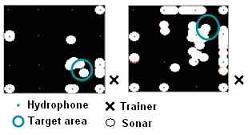Abstract
With their sophisticated sonar bottlenose dolphins can detect targets buried in sediment. In the waters off the Bahamas, wild dolphins have been observed detecting and extracting fish buried in coral sand, a behaviour called crater-feeding. Although echolocation is heard during this behaviour, its role is poorly understood; e.g. if the dolphins extract useful information from the sonar echoes from the buried fish or if they use other cues to detect the fish.
The aim of this study was to investigate if bottlenose dolphins can be trained to detect targets buried in coral sand, using their sonar, and if so, if they used any particular search strategy.

Three bottlenose dolphins at Dolphin Encounters, Nassau, Bahamas, were trained to find and retrieve targets, successively buried until invisible in a coral sand arena.
A hydrophone matrix mounted on a fabric was placed under a thin layer of sand in the test arena on the bottom of a sea pen and custom made computer software visualized the dolphins’ sonar beam pattern on a PC screen.

Throughout the training the dolphins seemed to rely much on cues from their trainers to find the targets. The typical search strategy was to echolocate in a scattered way in the direction where the trainer pointed. If not detecting the target within a few seconds, they continued this unsystematic echolocation until they did find it; often only after the trainer again pointed in the direction of the targets.
During seven days with 2-4 sessions per day they reached the point where they found buried targets after watching the trainer bury and pointing towards them, sometimes repeatedly, and sometimes by ploughing through the sand with their rostrum. This suggests that sonar was not the primary cue to detect the targets. However, it is still possible that they may be able to learn to detect buried targets by sonar. Detecting buried targets is a challenging task and these inexperienced dolphins were trained only during a short period of time. Further trials will explore the possibility that learning may enable them to extract useful information from their sonar echoes.
Responsible for this page:
Director of undergraduate studies Biology
Last updated:
06/05/07
